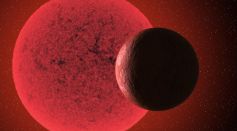Tags: Exoplanet
Isotopes Found in Exoplanet's Atmosphere for the First Time Yet
Exoplanets With "Goldilocks Zone" Could Host Life, NASA Suggests

Father, Son Helps NASA Find 2 Planets Orbiting Sun-Like Star
Rouge Exoplanets' Wandering Moons Might Be Habitable, Atmosphere and Water Found?
New Planet Discovered? Scientists Find Water Clouds in Exoplanet With Earth-Like Temperature
Hydroxyl Molecule Common on Earth Detected for the First Time in Ultra-Hot Exoplanet's Atmosphere

New Super-Earth Found: Does It Orbit a Red Dwarf Star in 2.4 Days?

NASA's Roman Mission: Will Nancy Grace Roman Telescope Find 100,000 Exoplanets?

First Ever Tectonic Activity on Exoplanet Full of Volcanoes Recorded

Titan Atmosphere Simulated in Research Lead by IBM: Possible Key to Knowing Origin of Earth Life

Researchers Discover Jupiter-Like Exoplanet that has Complex Weather System

Did These Two Teenagers Found Four Planets Orbiting a Nearby Star?

Meet OPH 98, A Pair of Weird Binary Wandering Across The Universe

TRAPPIST-1 Planets May Have Unusual Similar Compositions, NASA Says

Experts Found At Least Six Super-Earths Dancing Around a Star; What Makes It Special?

Experts Discovered a Weird, Hot Jupiter as It Passed Through a Star
“Cotton-Candy” Exoplanet WASP-107b Apparently Has Less Core Mass Than Previously Thought

'Super-Earth' Orbiting One of Milky Way's Oldest Stars, Observed

Space Telescope Ariel: Europe Moves Ahead With Exoplanet Mission
Stellar Flares Affect the Habitability of Exoplanets
Most Popular

10 Powerful Brain-Boosting Foods Backed by Nutrition Science to Enhance Cognitive Function

If the Sun Were a Basketball, How Big Would the Earth Be? Space Scale Comparison Perfect for Kids

Top 10 Invasive Species List: Shocking Biodiversity Threats Ravaging Ecosystems Worldwide

12 Common Brain Myths Debunked: Surprising Neuroscience Facts You Need to Know




